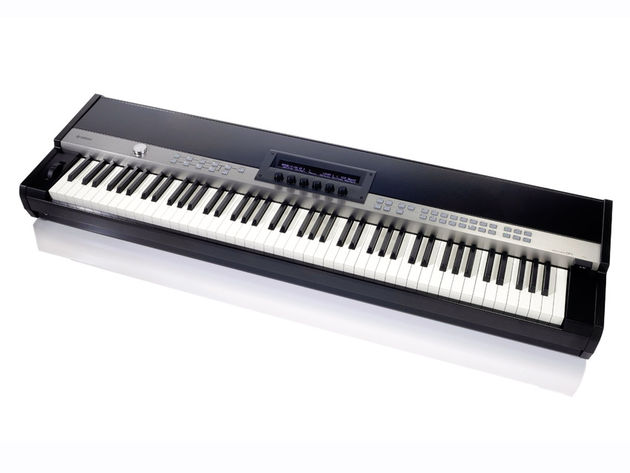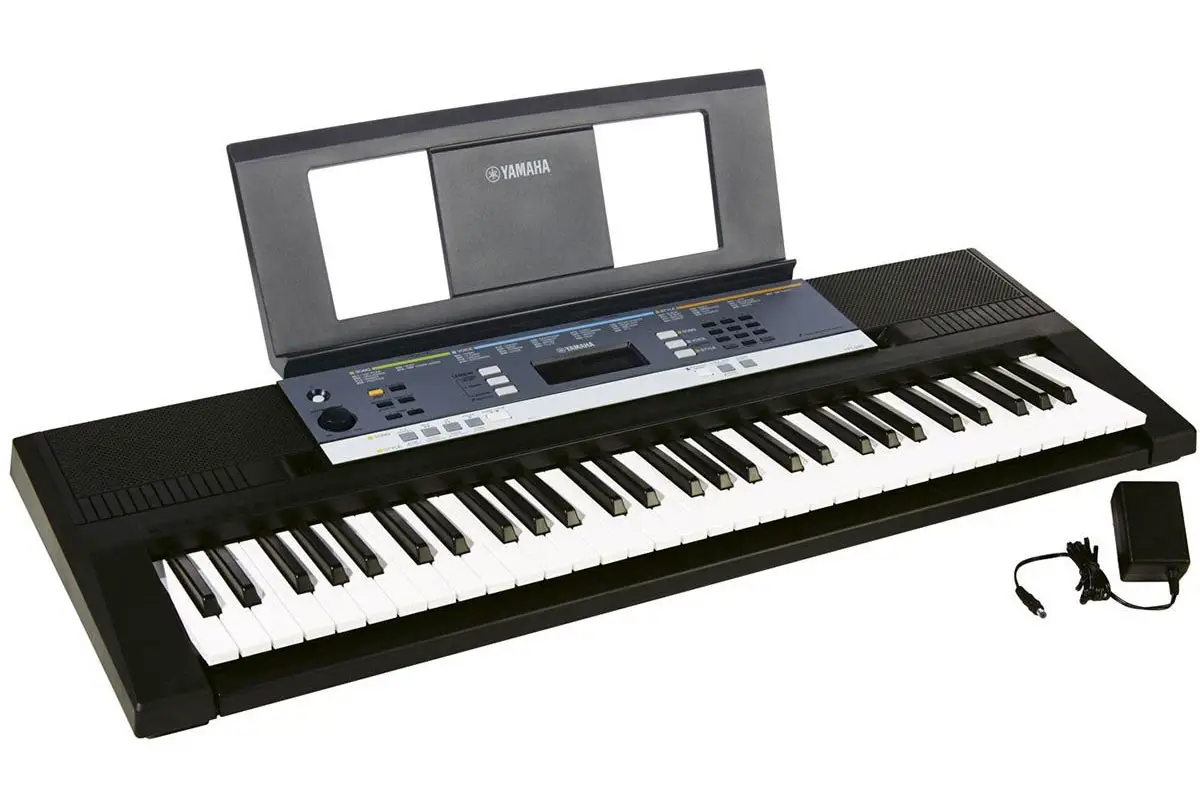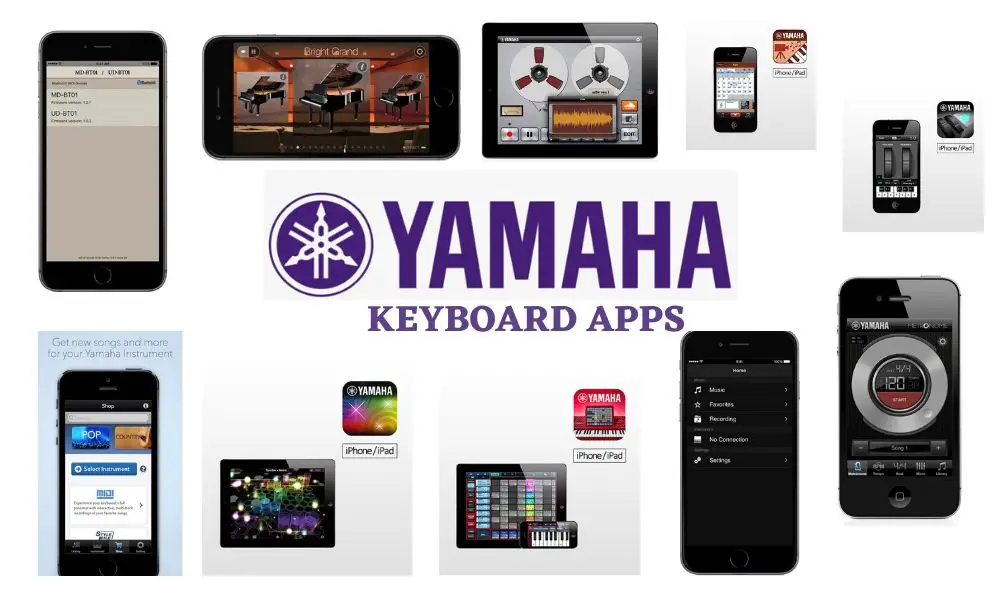
The Yamaha PSR EW300 76-Key Portable Keyboard Bundle has a 76-key touch sensitive keyboard, and is designed for intermediate piano players who have outgrown a beginner, 61-key keyboard and want a wider range of notes, tones, capabilities, and expressions. It has excellent built-in learning functions and a big suite of digital effects, to take your piano playing to the next level.
Table of contents
- Yamaha PSR EW300 Overview
- Video Overview of Yamaha PSR-EW300
- Yamaha PSR-EW300 FAQs
- Yamaha PSR-EW300 Specifications
- Who is the Yamaha PSR-EW300 SA Most Suitable For?
- What’s Included In the Box?
- Yamaha PSR-EW300 Features
- Pros & Cons of Yamaha PSR-EW300
- Yamaha PSR-EW300 Manual
- An Alternative Product
- Yamaha PSR-EW Series – The Talent Show
- Conclusion
Yamaha PSR EW300 Overview

While 61-key keyboards are a great way to start learning the piano, and are lightweight and portable, as a player progresses, eventually they want to have a greater range of notes and chords at their fingertips. For intermediate learners, a 76-key keyboard enables greater exploration and expression, without the weight and bulk of a full-size 88-key keyboard.
The EW-300 was introduced last year as an update to their popular YPG235 model, with upgraded features and a new look. The YPG 235 is widely praised by music lovers and piano experts alike, and the PSR-EW300 continues the famous Yamaha quality and sound in a new model.
Video Overview of Yamaha PSR-EW300
Here’s a quick video overview by Yamaha.
Yamaha PSR-EW300 FAQs
It came out in 2017.
The dimensions of the Yamaha PSR-EW300 are 45 x 4.6 x 15″ (1152 x 118 x 369 mm).
The weight of the Yamaha PSR-EW300 is14 pounds (6.2 kg)
The Yamaha PSR-EW300 costs around $270 but it can vary depending on where you buy it.
It has total 76 Keys.
The Yamaha PSR-EW300 have 574 preset sounds.
You can see a demo here: Yamaha PSR-EW300 demo
You can see an unboxing here: Yamaha PSR-EW300 unboxing
It is available in large shops including Walmart and Amazon.
It has standard stereo phone jack (PHONES/OUTPUT).
The Yamaha PSR-EW300 costs $70 more than the Yamaha EZ 220 and they have good difference in features.
The similarities of two models are:
– Both of them have one touch and multi-finger setting function.
– Both of them use General MIDI and XGlite.
– They use TRS Headphone for Output but only Yamaha PSR-EW300 has auxiliary audio input.
– They have same amplifiers and round speakers.
– Both of them use PA-130 / PA-3C, 12 VDC power adopter and 6 x AA type batteries.
The differences between the two models are:
– Yamaha PSR-EW300 has 76 keys and Yamaha EZ 220 has 61 Organ Keys.
– Yamaha PSR-EW300 has 574 sound presets but Yamaha EZ 220 has 392 sound presets
– Yamaha PSR-EW300 has 154 songs presets and Yamaha EZ 220 has 100 factory and 1 Demo songs presets.
– Yamaha PSR-EW300 has maximum 48 polyphony but Yamaha EZ 220 has maximum 32 polyphony.
– Number of Style Presets: Yamaha PSR-EW300 has 165 Factory and 10 User style presets. Yamaha EZ 220 has 100 style presets.
– The dimensions of the Yamaha PSR-EW300 are 45 x 4.6 x 15″ (1152 x 118 x 369 mm) and weighs 14 pounds (6.2 kg). Yamaha EZ 220 has dimensions of 37.2 x 4.4 x 13.7″ (94.5 x 11.1 x 34.8 cm) and weighs 9.7 pounds (4.4 kg)
Price of Yamaha PSR-EW300 is $40 more than Casio WK-245 and there are quite a few differences between them.
Their similarities are:
– Both the models have 76 keys each.
Their differences are:
– Yamaha PSR-EW300 has 154 songs presets, 175 style presets and 574 sound presets. But Casio WK-245 doesn’t have these function.
– Yamaha PSR-EW300 has reverberation and chorus as well as maximum 48 polyphony. But Casio WK-245 doesn’t have these function.
– Yamaha PSR-EW300 uses General MIDI and XGlite. Casio WK-245 doesn’t use MIDI.
– Yamaha PSR-EW300 has connections of auxiliary audio input, headphone output and sustained pedal input which doesn’t exist in case of Casio WK-245.
– Yamaha PSR-EW300 has 2 x 2.5 W amplifiers and 2 x 4.7″ / 12 cm round speakers.
– Yamaha PSR-EW300 uses PA-130 / PA-3C, 12 VDC power adopter and 6 x AA type batteries. Power adopter of Casio WK-245 is included and uses 6 x D batteries.
– The dimensions of the Yamaha PSR-EW300 are 45 x 4.6 x 15″ (1152 x 118 x 369 mm) and weighs 14 pounds (6.2 kg). The dimensions of Casio WK-245 is 45.7 x 15.2 x 5.3″ (1161 x 385 x 134 mm) and weighs 15.2 pounds (6.9 kg)
Yamaha PSR-EW300 Specifications
| Specification | Description |
|---|---|
| Keys | 76 touch-responsive keys |
| Weight | Weighs under 14 lbs. without batteries |
| Display | Backlit LCD display |
| Preset Songs | 154 preset songs, with touch tutor, chord study, and chord progression |
| Reverb Settings | 12 types of reverb |
| Polyphony | 48 max levels of polyphony |
| Style | 165 preset styles with style control, and 10 external styles |
| Harmony | 26 types of harmony |
| Voice & Effects | 574 total instrument voices, with 197 panel voices, 18 drums and effects, 20 arpeggio, and 339 XGlite voices |
| Functions | – Dual, split, and duo keyboard functions – Melody suppressor function – Transpose and tuning functions – Auto power-off function |
| Jacks & Ports | – Headphone jack – Sustain pedal jack – AUX IN stereo mini jack – USB to host port |
| Record and Playback | Record and playback up to 5 songs with 2 tracks with onboard memory |
| Power | Can be battery powered with 6 AA batteries |
| Accessories | – Bundle includes music rest – Bundle includes power supply |
Who is the Yamaha PSR-EW300 SA Most Suitable For?

EW 300 is designed for intermediate piano players and aspiring musicians who want a greater range of notes, chords, and tones than they can achieve with a small, 61-key keyboard.
It’s perfect for students who have outgrown their smaller keyboard, and want to further progress and challenge themselves with their playing.
It is also an excellent choice for completely new players, with all the Yamaha educational and learning features of their smaller keyboards designed for novices. The automated accompaniment capabilities and intelligent action of this keyboard will have even beginners playing complete songs in no time.
What’s Included In the Box?


The PSR-EW300 comes with a detachable music rest, a power supply, and the PKBS1 keyboard stand. This X-style keyboard stand folds into a slim footprint for travel or storage, with durable construction and non-slip rubber feet for stability. It has a circular locking mechanism and a quick-change knob to adjust to six different playing heights, from 25.63” to 38.75”. It can be used to play the keyboard seated or standing, and weighs just 6 lbs.
Yamaha PSR-EW300 Features
This digital piano is packed with some great features; let’s take a look at some of them:
| FEATURE | DESCRIPTION |
|---|---|
| Design | The keyboard weighs less than 14 lbs. without batteries. The ability to play with AC or with battery power helps the portability of this keyboard, which can be easily taken outdoors to play, travel with a family, or go to and from practice. |
| Sound | EW-300 is driven by the famous Yamaha AWM stereo sampling sound engine. It’s not Yamaha’s best grand piano sound, but is an excellent sound engine that makes Yamaha beginner keyboards preferred by experts. |
| 76 touch-responsive keys | It has 76 touch-responsive keys, which play with louder volume depending on how hard the keys are pressed, just like an acoustic piano. |
| LCD display | The onboard buttons and menus are clearly labeled, the backlit LCD screen is easy to read as it guides you through settings, functions, or piano lessons. |
| Includes | It comes with the necessary power supply, and a slim, adjustable, x-style keyboard stand, so you can begin playing right out of the box. |
| Instrument voices | It comes with a whopping 574 total instrument voices, with 197 panel voices, 18 drums and effects, 20 arpeggio, and 339 XGlite voices for a huge range of sound capabilities. |
| Built-in | Built-in arpeggio and a number of arpeggio styles and options adds even more capabilities for musical styles and sounds. |
| Functions | It has duo, split, and keyboard functions, so you can share the keyboard with another player, or produce multiple instrument voices with every touch. |
| One-touch setting | Registration buttons, one-touch setting, and grand piano button allow you to not only customize your settings as you prefer, but quickly store and save them, or immediately return to the factory default with grand piano. |
| Preset Songs | With 154 preset songs and 165 preset styles, it has everything you need to learn and play nearly any type of music. It has a large range of reverb, chorus, harmony, and EQ settings for customizing your sound, and 48 levels of polyphony allow for complex, overlapping, nuanced music. |
| Yamaha Education Suite | The included Yamaha Education System has a number of capabilities to help new piano players learn and grow. With the downloaded song book, you can read music and play along with the onboard songs in the keyboard. It has easy, step-by-step lessons and practice, along with “touch tutor” lessons for learning dynamic expression. The education system will also track and grade your lessons as you progress. |
| Transpose and tuning functions | Transpose and tuning functions allow you to adjust the instrument to your preference, particularly when playing along with other instruments or vocalists. |
| Features | A library of 165 musical styles and style controls, including auto fill and other options, allows you to explore any music style you choose. |
| Melody Suppressor feature | The Melody Suppressor feature can suppress the vocals on tracks when they are played through the keyboard, allowing you to play or sing along without competition. |
| Automatically power off | When it is idle for a while, it will automatically power off, saving your battery life or energy costs. |
| Connectivity | It has headphone and pedal jacks, as well as AUX IN to connect a music player, and USB to host for connection to computers and mobile devices. |
Pros & Cons of Yamaha PSR-EW300
| PROS | CONS |
|---|---|
| Lightweight and battery power for portability | Non-weighted keys |
| 76 touch-responsive keys mimic the feel and experience of playing an acoustic piano | |
| Backlit LCD display is bright and easy to read | |
| Yamaha’s famous AWM stereo sampling sounds superior to other intermediate keyboards | |
| 48 max levels of polyphony support the complexity of reverb, chorus, and harmony settings, as well as the optional sustain pedal, for complex and overlapping sounds and nuanced expression | |
| 574 total instrument voices, with 197 panel voices, 18 drums and effects, 20 arpeggio, and 339 XGlite voices for a huge range of sounds and styles from a single instrument | |
| Dual, split, and duo keyboard functions allow you to share the keyboard or produce multiple instrument sounds at once. | |
| 154 preset songs, with touch tutor, chord study, and chord progression, 158 music database, 150 types of built in arpeggio, and 165 preset styles with style control, allow you to explore and experience everything this keyboard is capable of musically, and play an entire orchestra of instruments | |
| The many settings in the Master EQ also allow you to curate and customize these sounds as you prefer. Store and restore your settings using One Touch, or immediately create the sound and acoustics of a grand piano with the grand piano button | |
| The Melody Suppressor function is helpful when playing along with pre-recorded songs, so that you can fill in the melody yourself. It’s great for learning and for performing | |
| You can record and playback up to 5 songs with 2 tracks each with onboard memory, or use USB to host to record and share your music |
Yamaha PSR-EW300 Manual
If you’d like to check out the nitty-gritty of the EW-300, here’s a link to the model’s manual:
CLICK TO DOWNLOAD EW300 MANUAL
An Alternative Product
With 76 non-weighted keys, the EW-300 is an intermediate keyboard, and, as such, represents a decision point in a musician’s interests and aspirations. While it is a friendly and easy-to-learn keyboard for absolute beginners, it is intended to be an upgrade for those who have learned the basics of playing piano on a 61-key keyboard, and now want greater range, greater possibilities, and greater capabilities in their instrument.
For those who want to go on to play acoustic, grand pianos in the future, or who are practicing at home and taking lessons or performing on analogue pianos, EW-300 actually isn’t the best choice.
Once a beginner has learned the basics of piano playing on a 61 key keyboard, it would be better to progress to a full-size, fully weighed keyboard, so that their digital practice sessions build the finger strength and technique they will need on an acoustic piano.

For those who want to play a concert piano in the future, a better choice would be to invest in the Yamaha P71 88-key Weighted Action Digital Piano.
The P71 has the same great Yamaha AWM sound engine as the PSR-EW300, and a broad range of instrument voices and advanced settings, but has the crucial full size keyboard and fully weighted keys that will make the most of every practice session, and open up the full range of piano compositions and musical expression for the student.
For those aspiring musicians who are familiar with a 61-key keyboard, and want to grow both musically and professionally, a good alternative to the EW300 might be the Casio WK245 PPK 76-key Premium Portable Keyboard Package.

Like the EW300, the Casio WK245 has 76 keys and comes with an easy, step-by-step lesson system. However, the Casio has a greater range of instrument voices, digital features, and has much more robust onboard recording, mixing, and sampling capabilities for a musician who wants to not just learn, but to record, compose, and share their music.
Advantages of the Casio WK245

| – Higher levels of polyphony |
| – More instrument voices and rhythms |
| – Connects to Mac or PC |
| – MIDI export |
| – Onboard memory can record up to 5 songs with 6 tracks each, instead of 2 |
| – Onboard sampling and effects |
| – Microphone input |
| – Amazon bundle includes headphones |
Advantages of the EW-300

| – Great Yamaha grand piano sound engine |
| – Arpeggio capability |
| – Melody suppressor |
All three of these instruments are very good choices for intermediate musicians, but it’s helpful to identify whether you are playing the digital piano just for fun, or intend to grow into a concert pianist, or intend to start your own band. Knowing your goals will help an intermediate player make the digital keyboard upgrade that is best for them.
Yamaha PSR-EW Series – The Talent Show
Conclusion
The EW 300 is a great instrument, designed for intermediate learners.
However, it’s not the perfect choice for all intermediate learners; those who want to transition to an acoustic piano should also transition to a full-size weighted keyboard sooner rather than later, so that their practice time is more meaningful.
For piano beginners, casual players, and digital musicians, the EW-300 is an excellent choice.
We hope that you enjoyed this Yamaha PSR EW300 review and it will help you decide if this keyboard is the right choice for you.








